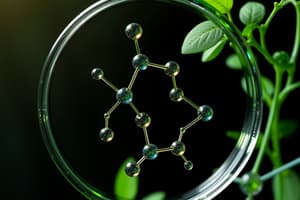Podcast
Questions and Answers
What is the main goal of Green Chemistry?
What is the main goal of Green Chemistry?
- To develop new toxic chemicals for industry
- To reduce or eliminate hazardous substances in chemical products and processes (correct)
- To promote the disposal of hazardous waste
- To increase the use of toxic solvents in manufacturing
Which of the following is NOT an element of Green Chemistry?
Which of the following is NOT an element of Green Chemistry?
- Heavy metal catalysts (correct)
- Green solvents
- Biocatalysts
- Ionic liquids
What are ionic liquids primarily composed of?
What are ionic liquids primarily composed of?
- Metals and organic compounds
- Water and salts
- Gases and liquids
- Cations and anions (correct)
Which principle does Green Chemistry emphasize regarding waste?
Which principle does Green Chemistry emphasize regarding waste?
What is the role of biocatalysts in Green Chemistry?
What is the role of biocatalysts in Green Chemistry?
How do green chemicals benefit the environment?
How do green chemicals benefit the environment?
Which of the following is an example of a Non-conventional energy source in Green Chemistry?
Which of the following is an example of a Non-conventional energy source in Green Chemistry?
What is primarily used in the composition of room-temperature ionic liquids (RTILs)?
What is primarily used in the composition of room-temperature ionic liquids (RTILs)?
What is the primary goal of safer chemical synthesis?
What is the primary goal of safer chemical synthesis?
Which method is NOT a part of solvent-free approaches in chemical synthesis?
Which method is NOT a part of solvent-free approaches in chemical synthesis?
How do solvent-free reactions benefit chemical synthesis?
How do solvent-free reactions benefit chemical synthesis?
What is an example of a renewable raw material?
What is an example of a renewable raw material?
Energy efficiency in chemical processes aims to minimize what?
Energy efficiency in chemical processes aims to minimize what?
Which of the following options accurately defines auxiliaries in chemical processes?
Which of the following options accurately defines auxiliaries in chemical processes?
What benefit is associated with the use of renewable raw materials in chemical synthesis?
What benefit is associated with the use of renewable raw materials in chemical synthesis?
How does energy-efficient technology like LED bulbs contribute to sustainability?
How does energy-efficient technology like LED bulbs contribute to sustainability?
What is a primary benefit of using renewable raw materials in chemical processes?
What is a primary benefit of using renewable raw materials in chemical processes?
What does the principle of 'reduction of derivatives' emphasize?
What does the principle of 'reduction of derivatives' emphasize?
Why is catalysis preferred over stoichiometric reagents in green chemistry?
Why is catalysis preferred over stoichiometric reagents in green chemistry?
What should chemicals be designed to do at the end of their functional use?
What should chemicals be designed to do at the end of their functional use?
Which principle encourages the real-time monitoring of analytical methods in chemistry?
Which principle encourages the real-time monitoring of analytical methods in chemistry?
How is atom economy measured in synthetic methods?
How is atom economy measured in synthetic methods?
What is the primary focus of the principle of accident prevention in green chemistry?
What is the primary focus of the principle of accident prevention in green chemistry?
Which practice is aligned with the prevention of waste principle in daily life?
Which practice is aligned with the prevention of waste principle in daily life?
What is the primary function of a catalyst in a chemical reaction?
What is the primary function of a catalyst in a chemical reaction?
Which type of catalyst is specifically known to be derived from biological sources?
Which type of catalyst is specifically known to be derived from biological sources?
What key feature makes linear alkylbenzene sulfonate (LAS) effective as a surfactant?
What key feature makes linear alkylbenzene sulfonate (LAS) effective as a surfactant?
Why does the branched version of a detergent fail to degrade as efficiently as the linear version?
Why does the branched version of a detergent fail to degrade as efficiently as the linear version?
In the context of green chemistry, why is catalysis considered beneficial?
In the context of green chemistry, why is catalysis considered beneficial?
What is a common application of enzymes in bio-catalysis?
What is a common application of enzymes in bio-catalysis?
Which process allows microbes to break down the carbon chain in LAS?
Which process allows microbes to break down the carbon chain in LAS?
What can be said about the degradation products of chemical products designed with green chemistry principles?
What can be said about the degradation products of chemical products designed with green chemistry principles?
Why have branched detergents been phased out in most developed countries?
Why have branched detergents been phased out in most developed countries?
What is one of the key advantages of using microwave-assisted synthesis?
What is one of the key advantages of using microwave-assisted synthesis?
What is a major limitation of microwave-assisted synthesis?
What is a major limitation of microwave-assisted synthesis?
Which of the following is NOT listed as a key action in accident prevention?
Which of the following is NOT listed as a key action in accident prevention?
What is one method mentioned for pollution prevention through analytical methodologies?
What is one method mentioned for pollution prevention through analytical methodologies?
What frequency range defines microwaves?
What frequency range defines microwaves?
What outcome can be achieved by using microwave heating compared to conventional heating?
What outcome can be achieved by using microwave heating compared to conventional heating?
Which of the following is an application of non-conventional energy sources?
Which of the following is an application of non-conventional energy sources?
Flashcards are hidden until you start studying
Study Notes
Green Chemistry
- Definition: Design of chemical products/processes to reduce or eliminate hazardous substances.
- Sustainability: Also known as sustainable chemistry, focusing on minimizing health and environmental risks.
- Focus Areas: Encompasses the entire lifecycle of chemicals – from design to disposal.
Principles of Green Chemistry
- Prevention of Waste: Aim to avoid the creation of waste rather than treating it post-generation.
- Atomic Economy: Methods designed to maximize the incorporation of all materials into final products, reducing molecular waste.
- Safer Chemical Synthesis: Design products to achieve desired functions while minimizing toxicity.
- Safer Chemicals Design: Prioritize chemical products that degrade into harmless materials post-use.
- Use of Safer Solvents and Auxiliaries: Minimize auxiliary substances not directly contributing to reaction products.
- Energy Efficiency: Recognize environmental impacts of energy usage and minimize energy requirements in processes.
- Use of Renewable Raw Materials: Favor renewable resources that can be replenished quickly over nonrenewable materials.
- Reduction of Derivatives: Avoid unnecessary derivatization that requires additional reagents.
- Catalysis: Employ catalytic instead of stoichiometric reagents for reduced waste and enhanced efficiency.
- Degradation Products Design: Create chemicals designed to decompose into non-toxic products.
- Real-Time Analysis for Pollution Prevention: Employ analytical methods for monitoring processes to prevent hazardous substances.
- Accidents Prevention: Select substances and usage methods to minimize risks of accidents like leaks or explosions.
Ionic Liquids
- Description: Salts that are liquids at or below 100°C, including room-temperature ionic liquids (RTILs).
- Applications: Used in synthesis, analytical equipment, lithium-ion batteries, and as lubricants or coolants.
Energy Sources in Green Chemistry
- Non-Conventional Energy Applications: Utilize microwave, ultrasonic, electro-synthesis, and solar energy in synthesis.
- Microwave Synthesis: Significantly reduces reaction times compared to conventional heating methods, enhancing yields and purity.
Environmental Benefits
- Decreased global warming potential, ozone depletion, and ecosystem disruption.
- Reduced harmful impacts on plants and animals due to lower toxicity of chemicals used.
Examples and Applications
- Renewable Materials: Biomass, wood, and natural fibers (bamboo, cotton) that can regenerate quickly.
- Types of Catalysts: Includes enzymes and acid-base catalysts to improve reaction efficiencies.
Safety Considerations
- Importance of constructing safe procedures and setting up emergency plans to handle potential accidents effectively.
Studying That Suits You
Use AI to generate personalized quizzes and flashcards to suit your learning preferences.




